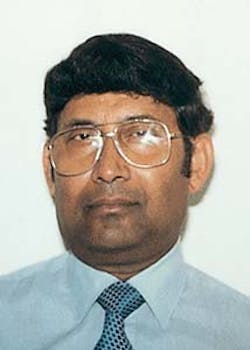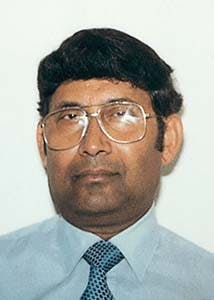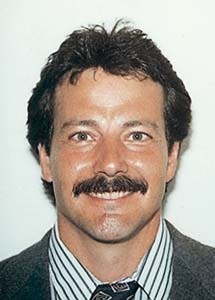Program determines rod-pumped well inflow performance
Roy EngineerA computer program was developed to generate the inflow performance relationship (IPR) for rod-pumped oil wells.
Aera Energy LLC
Bakersfield, Calif.Gary Grillette
Bechtel Petroleum Operations Inc.
Tupman, Calif.
Input data obtained from two acoustical surveys are used by this Windows-based program, RodIPR, for quickly predicting the IPR for rod pumped oil wells.
The required reservoir conditions at test time are that Pb Ps Pwf, or in other words, static well bore (Ps) and bottom hole flowing (Pwf) are below the bubble point pressure (Pb).
This IPR program can be used to increase a well's production rates by optimizing the rod pump's speed, stroke length, and size. Other practical uses for the program include:
- Optimizing the pump setting depth, assuming a pumped-off condition.
- Optimizing the casinghead pressure, if the casing annulus is tied into well's flow line.
Program concept
RodIPR uses the method developed by K.E. Brown. 1 Two acoustical surveys (one each for static and dynamic conditions) are needed to generate the corresponding static well bore (P s) and bottom hole flowing (P wf) pressures.When a well is producing oil and water, the question that needs to be answered is: "What percentage of water and oil will be standing in the casing annulus under static and producing conditions?" In the program, the following two assumptions are made:
- Under static conditions, the liquid column will consist of oil standing in the annulus above the pump and water settling below the pump.
- Under flowing conditions, the liquid column standing in the annulus above and below the pump will be the same oil and water percentage as the well's production.
Calculations
The steps for obtaining the IPR curve from the acoustic survey data include calculating the static (P s) and flowing (P wf) pressure at pump depth, correcting the calculated P s and P wf at depth to the mid-point perforations (MPP), and then generating the IPR curve.Static pressure
To calculate static pressure (P s) at pump depth, a simplified gas-column pressure equation can be used for low casinghead pressure as follows:P = Psurface (1 + Fluid level depth from surface/40,000)
The liquid column pressure is then calculated with the following equations:
go = 141.5/(131.5 + API) Oil gradient = go 3 0.433 psi/ftOil column pressure = Oil column * Oil gradient
The well bore static pressure at pump depth is:
Ps = Gas column pressure + Oil column pressure
Flowing pressure
Four steps are used to calculate the flowing pressure (P wf) at pump depth.- Step 1. Estimate first pass Pwf as follows:
Pwf = Gas column pressure (Ps) + (Oil cut * Liquid column * Oil gradient) + (Water cut * Liquid column * Water gradient)
- Step 2. Estimate the gas correction factor (GCF). The liquid column in the annulus needs a GCF to account for the gas bubbling through it at flowing conditions. For this, Podio's "S" curve2 can be used.
- qg = Gas production rate, MMscfd
- P = Average pressure in the liquid column, psig
- T = Average temperature in the liquid column, °R.
- Z = Average gas compressibility at P and T
- A = Annulus cross-sectional area, sq in.
Podio's "S" curve2 (Vsg vs. liquid GCF) is included in the program in tabular form. GCF is estimated from the calculated Vsg.
- Step 3. Estimate corrected liquid gradient and liquid column pressure. The corrected liquid gradient is estimated from:
- Step 4. Estimate bottom hole flowing pressure (Pwf) from:
If the calculated Pwf in Step 4 is 10 psi greater than the Pwf in Step 1, then additional iteration would be necessary for convergence.
Ps, Pwf correction
The Ps and Pwf at pump depth need to be corrected to the mid-point perforation (MPP) depth.Three cases are considered:
1. If the pump is set above MPP depth, then:
Ps at MPP = Ps at pump depth + ((MPP - Pump depth) * Water gradient)
Pwf at MPP = Pwf at pump depth + ((MPP - Pump depth) * Corrected liquid gradient)
2. If pump is set at MPP, then:
Ps at MPP = Ps at pump depth
Pwf at MPP = Pwf at pump depth
3. If the pump is set below MPP, then:
Ps at MPP = Ps at pump depth - ((Pump depth - MPP) * Water gradient)
Pwf at MPP = Pwf at pump depth - ((Pump depth - MPP) * Corrected liquid gradient)
IPR curve
The test condition P b P s P wf must be met before generating the IPR curve.Because the static reservoir pressure is less than the bubble point pressure, Vogel's equation3 (Equation 2) is used to generate the oil IPR.
The water IPR is generated with a straight-line productivity index because water is basically incompressible.
In Equation 2, qm is the maximum theoretical oil rate, in b/d, when the pressure is lowered to atmospheric pressure. The water IPR is calculated using a straight-line productivity index, J.
The two sets of IPR data are then added together for generating the total liquid IPR for the well.
Program use
Rodipr is a user-friendly program. Table 1 [13,309 bytes] shows an example of the program input for a hypothetical rod-pumped well. The input includes the production data, tubing configuration, and acoustic data for the well.The example problem objectives are:
- To generate an IPR curve for the well
- To analyze if the production rate can be optimized by keeping the well "pumped-off" at the current depth of 6,000 ft and lowering the dynamic casing pressure from 80 to 50 psi.
For optimizing the production rate, the user can click on the "Pump-Off Conditions" in the program menu. The "Pump-Off Conditions" places the fluid level at the pump and allows the user to vary the pump depth and the dynamic casing pressure, if desired.
In the example, the pump depth of 6,000 ft is maintained and a new dynamic casing pressure of 50 psi is entered. The default Z of 0.975 is used.
For this case (Table 3 [10,519 bytes]), the IPR for the well does not change. Only the Pwf at pump depth changes. The new Pwf is 215 psi.
The production rate at this pressure is 62 bo/d and 43 bw/d. Therefore, the production can be increased by about 12 bo/d by lowering the casinghead pressure to 50 psi and keeping the well pumped off.
The user is cautioned that when changing the dynamic fluid level or casing pressure for a well from the "Acoustic Data" menu, the corresponding fluid rates should also be changed to maintain the well's IPR relationship.
In the example problem, if the user wished to return to the original conditions by changing the dynamic fluid level back to 5,500 ft and the dynamic casing pressure back to 80 psi, the production rates must also be changed back to 50 bo/d and 30 bw/d, respectively, to maintain the original IPR.
Considerations
RodIPR is a practical and useful program. It requires a minimal amount of data to generate the current IPR curve for a rod-pumped well. The user can also optimize separator pressure and pump depth (with pumped-off conditions).It should be noted that many operators prefer to maintain a 100 to 300-ft liquid column above the pump. Other operators do not hesitate to pump the well off.
In pumped-off conditions, the pump and rod life may be shortened. Experience and individual well conditions apply to each case.
The program generates the IPR for a rod pumped well when the reservoir condition is Pb Ps Pwf. However, if the reservoir condition is that Ps Pb Pwf, then the user can use the Pwf and Ps values generated by this program and input this data in the IPR program in Reference 4 to generate the IPR curve for the well.
Acknowledgment
The authors thank Stan Roy of Pinnacle Software for his support in developing this software, and Brian Holcomb of Area Energy for technical assistance.References
- Brown, K.E., The Technology of Artificial Lift Methods, Vol. 4, PennWell Books, Tulsa, 1984.
- Podio, A.L., M.J.Tarrillion, and E.T. Roberts, "Laboratory work improves calculations," OGJ, Aug. 25, 1980, pp. 137-46.
- Vogel, J.V., "Inflow Performance Relationships for Solution Gas Drive Wells," JPT, January 1968.
- Engineer, R., and Grillette, G. "Program solves for oil well inflow performance", OGJ, June 23, 1997.
Subscribers outside the U.S. should send the diskette and return mailer without return postage to the same address. This mail offer will expire May 31, 1998.
The Authors
Roy Engineer is a staff reservoir engineer with Aera Energy LLC. He has over 20 years of oil field experience. Engineer has BS and MS degrees in petroleum engineering and is a registered Professional Engineer.
Gary Grillette is a senior production engineer for Bechtel Petroleum Operations Inc. He has 15 years of oil field experience. Grillette holds a BS in petroleum and natural gas engineering from Penn State University.
Copyright 1997 Oil & Gas Journal. All Rights Reserved.


